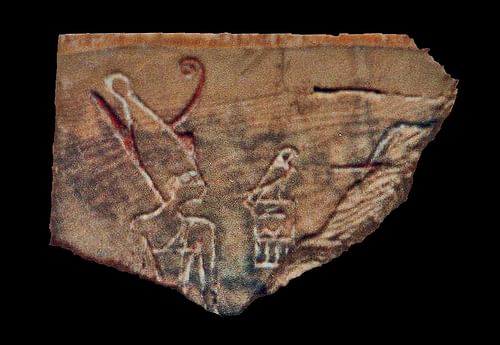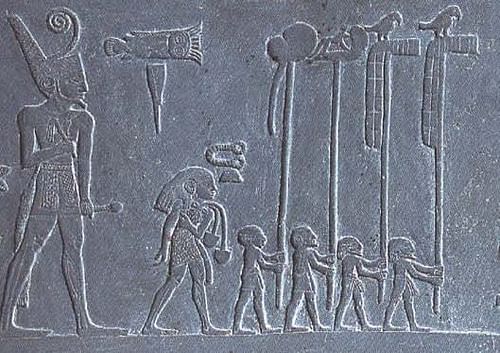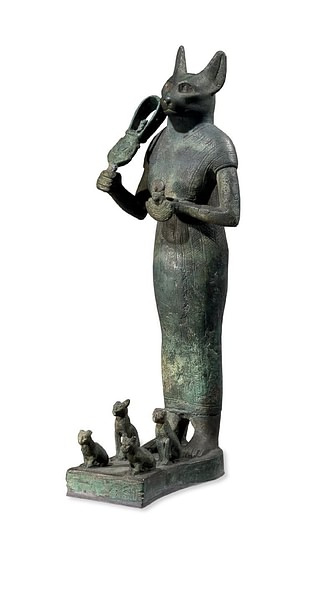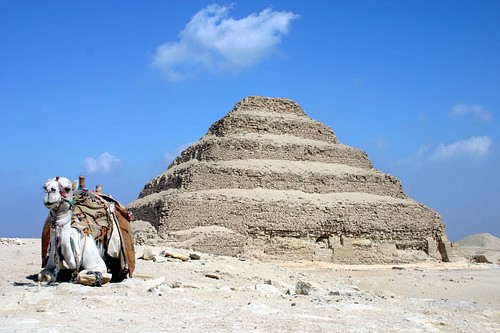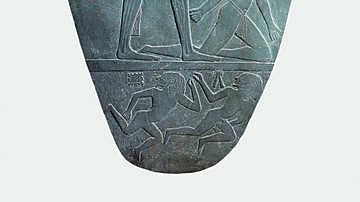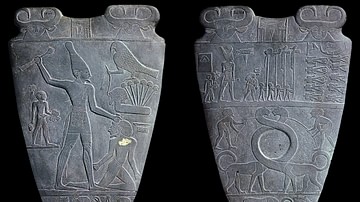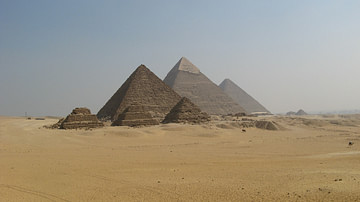Egypt's Early Dynastic Period (3150-2613 BCE) lay the foundation of what would become one of the most impressive civilizations of the ancient world. The kings of this era, except for Narmer and Djoser, are often overlooked but were responsible for some of the most defining aspects of Egyptian culture. This is not to say that the Early Dynastic Period has been completely neglected; only that it does not receive the kind of attention given to later eras in Egyptian history. One major reason for this is the problem of source material. The Early Dynastic Period is prehistoric - any written records pertaining to it come from centuries later - and so it is difficult, especially during the Second Dynasty (c. 2890-2670 BCE), to determine who ruled when and what exactly their contributions were. Written records such as Manetho's chronology, the Turin King List, the Palermo Stone, and others were created much later and also, as egyptologist James Henry Breasted writes:
Comparatively speaking, but very little of the rich and productive civilization, which flourished for at least five milleniums before Christ on the banks of the lower Nile, has survived in written documents for our enlightenment (43).
IDENtifying contributions in Prehistoric Times
The contemporary records of the Early Dynastic Period consist of images and, later, inscriptions on stone monuments. Statuary and other building projects may give the name of the monarch or can, at least, be dated to a certain time period but, for the most part, such dates must be approximations. Even so, there is enough evidence available that one may safely list the most important kings of this period in regard to the most significant developments in culture and civilization. These rulers were known as kings, not pharaohs; the title 'pharaoh' would not appear in Egypt until the period known as the New Kingdom (1570-1076 BCE).
The most significant rulers of this era were Narmer, Den (First Dynasty), Raneb and Peribsen (Second Dynasty), and Djoser (Third Dynasty). One could also list Merneith, the first female ruler of Egypt during the First Dynasty who provided her son Den with a stable country when he took the throne; but no details of her reign are available and it is uncertain in what capacity she ruled. One might also list Nynetjer of the Second Dynasty who is thought to have decreed equal rights for women to rule and may have saved the country from famine by dividing it into two, but these claims are contested and the evidence is unclear.
All four kings of the Third Dynasty could be included as making lasting contributions if one could be sure who, exactly, did what. Sekhemket, the second ruler of the Third Dynasty, has long been credited with construction of his Buried Pyramid, and Khaba, the third king, with the Layer Pyramid but the latter has also been attributed to Huni, the last king, and Sekhemkhet's pyramid is no longer considered to have been built for him but for his wife. This distinction of which royal personage the pyramid was built for may seem trivial but is not; each tomb in ancient Egypt was custom built for a particular individual and so determining which person a pyramid was built for positively identifies that structure and its significance. Djoser, then, is chosen as the most important ruler of the Third Dynasty because his Step Pyramid at Saqqara is the first known pyramid built in ancient Egypt and was definitely built for this king as his final home.
The other kings are included in this list because of equally significant contributions to Egyptian culture: Narmer united Upper and Lower Egypt, Den is the first ruler depicted wearing the dual crown of both kingdoms, Raneb linked the position of the king to the gods (a practice well known from pharaonic times), and Peribsen encouraged literacy. The first complete sentence from ancient Egypt found thus far, in fact, comes from Peribsen's tomb.
According to Manetho's chronology, the first king of Egypt was Menes who united Upper and Lower Egypt. Menes has come to be identified with the king Narmer (c. 3150 BCE) and also with Narmer's successor Hor-Aha (c. 3100 BCE). It is likely that 'Menes' was a title (an honorific meaning 'He Who Endures'), not a personal name, and so Narmer has been generally accepted as the founder of the First Dynasty of Egypt ever since egyptologist Flinders Petrie (1853-1942 CE) concluded that Menes and Narmer were the same person.
Narmer
Narmer (probably from Thinis) married the princess Neithhotep of Naqada in an alliance to strengthen ties between the two cities. He led military expeditions through Lower Egypt to put down rebellions and expanded his territory into Canaan and Nubia. He initiated large building projects, and under his rule urbanization increased. The cities of Egypt never reached the magnitude of those in Mesopotamia, perhaps owing to the Egyptians' recognition of the threats such development posed. Mesopotamian cities were largely abandoned due to overuse of the land and pollution of the water supply while Egyptian cities, such as Xois (to choose a random example), existed for millennia. Although later developments in urban development ensured the cities' continuation, the early efforts of kings like Narmer would have provided the model.
Narmer was succeeded by his son Hor-Aha c. 3100 BCE (though some claim the two are the same person) who continued his father's military expansion and increased trade. He was especially interested in religion and the concept of the afterlife and the mastaba tomb (a house for the deceased) was developed under his reign. Hor-Aha was succeeded by his son Djer in c. 3050 BCE and continued the same policies as his predecessors. His son, Djet (c. 3000) married the princess Merneith and, upon his death, she is thought to have assumed control of the country. It is unclear whether she reigned as regent for her young son Den or ruled as queen but, either way, her reign marks the first time a woman ruled in ancient Egypt.
Den
Her son, Den (c. 2990 BCE) was the sixth king of the First Dynasty and considered the greatest. He ruled for 50 years, during which time the country prospered. His reputation as an effective king comes from his improvements to the country's economy, military conquests, and the stability of his reign as evidenced by lavish building projects and intricate works of art. Den is the first king to be depicted wearing the crowns of Upper and Lower Egypt, clearly indicating a united nation under his rule. Den was followed by two other kings, Anedjib and then Semerkhet, who experienced difficult reigns marked by insurrection. The dynasty ended with the reign of Qa'a whose successors fought for the throne and were subdued by Hotepsekhmenwy who founded the Second Dynasty.
Raneb
Raneb (also known as Nebra, Greek Name: Kaiechos) was the second king of the Second Dynasty and possibly the brother of Hotepsekhmenwy. He ruled for approximately 15 years and may have seized power in a coup. He is the first Egyptian king to add the name of the sun god Ra to his name and thereby directly link himself and the title of the king to the gods (a practice which would continue throughout Egypt's history and would come to define the office of the ruler of Egypt). The ruler as a living divinity, not a mere man, elevated the status of the office and linked the ruler to the cultural understanding of earthly life mirroring eternity. This link would have profound consequences for the culture of Egypt in that the supreme leader was not thought to have been merely chosen by the gods but was divine himself and so his edicts were necessarily good and just, simply by definition. Religious practices developed further under Raneb than they had since the reign of Hor-Aha. Images of the goddess Bastet (depicted as a cat or a woman with a cat's head) first appear under his reign and other religious iconography became more widespread, arguing for a more peaceful and productive rule than his predecessor; though this is by no means certain and there is evidence the country continued to experience civil unrest and rebellion.
Peribsen
Peribsen (also known as Seth-Peribsen) was the sixth king of the Second Dynasty and is considered an important ruler for the cultural changes which took place under his reign as well as for his name which replaced the god Horus with his rival Set. Horus the Younger was the son of the god Osiris who defeated Osiris' brother (and murderer) Set to restore balance to Egypt. It has been suggested that Peribsen's adoption of Set's name indicates a significant change in the religious orientation of Egypt at this time. Since Peribsen's name does not appear on any records of Lower Egypt, however, it has also been claimed that he ruled over a divided country and opted to distance himself from the Cult of Horus for political reasons. It has further been suggested that Peribsen was the first monotheist (predating Akhenaten by centuries) but this claim has been largely discredited as there is evidence of many different gods under his reign. Peribsen re-organized the bureaucracy of Egypt and encouraged literacy and religious practice. The first complete sentence in Egyptian history dates from his reign and was found in his tomb. The sentence reads, "The golden one, he of Ombos, hath unified and handed over the two realms to his son, the king of Lower and Upper Egypt, Peribsen". According to scholar Marc Van de Mieroop, "Earlier inscriptions, often found on seals that were impressed on clay, were terse and provided little beyond people's names and titles (30)." The sentence found in Peribsen's tomb, on the other hand, clearly states how the god Set ("he of Ombos") legitimized the rule of Peribsen. The pharaoh Khasekhemwy, last king of the Second Dynasty and father of Djoser, followed Peribsen.
Djoser
Djoser (c. 2670 BCE; Greek Name: Tosorthros) was the first king of the Third Dynasty and reigned for over twenty years. He ruled over a stable country as evidenced by the luxury of being able to engage in a number of building projects. Djoser built so many monuments, tombs, and temples, in fact, that scholars have claimed he must have reigned for closer to 30 years. Military expansion into the Sinai region took place under his reign and industry and technology flourished as did the arts. His vizier, Imhotep, designed his burial place at Saqqara; the great Step Pyramid he is most famous for in the present day. His reign was followed by Sekhemket, Khaba, and Huni, the last king of the Early Dynastic Period.
The Step Pyramid began as a simple mastaba tomb with a flat roof and sloping sides, along the lines of many such tombs from earlier dynasties. The architect Imhotep, however, had a grander scheme in mind for the eternal home of his monarch. The Step Pyramid is a series of mastabas stacked on top of each other, each level a little smaller than the one beneath, to form the shape of a pyramid. Earlier mastabas were constructed of clay brick but the Step Pyramid was made of stone blocks on which were carved images of trees (sacred to the gods of Egypt) and reeds (possibly symbolizing The Field of Reeds, the Egyptian afterlife). When completed, the Step Pyramid rose 204 feet (62 meters) high and was the tallest structure of its time. The pyramid complex included a temple, courtyards, shrines, and living quarters for the priests covering an area of 40 acres (16 hectares) and surrounded by a wall 30 feet (10.5 meters) high. The actual chambers of the tomb were dug beneath the base as a maze of tunnels with rooms off the corridors to discourage robbers and protect the body and grave goods of the king. The Step Pyramid is the first known attempt of the Egyptians to create the type of monumental tombs the culture has become synonymous with. It was a very popular tourist attraction in its day and continues to draw visitors from all over the world 4,000 years later.
Legacy
These five kings lay the groundwork for future generations of rulers who added their own contributions and flourishes to Egypt's grand culture. The concept of the city originated in Mesopotamia but became refined in Egypt, religion and religious art did likewise, and architecture followed suit. All of Egyptian architecture, in fact, was inspired by their understanding of the cosmos and their place in it. The most obvious example of this is the great eternal homes of the pharaohs, the pyramids, but every temple, palace, or administrative building was also constructed with a focus on eternity. Raneb's decision to link the office of Egypt's ruler to the gods proceeded naturally from the cultural belief that the gods were close at hand and that every Egyptian life was only one part of an eternal journey. As a divine ruler, the king was responsible for making the earthly part of that journey as pleasant as possible. The degree to which these five rulers succeeded in that has been debated but there is no doubt that Narmer, Den, Raneb, Peribsen, and Djoser set a standard which later Egyptian monarchs would then need to meet or exceed.
